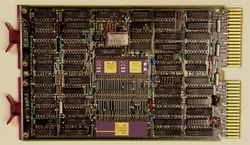Difference between revisions of "KDF11-A CPU"
(+jumpers, details) |
m (→Further reading: +MMU Configuration Jumpers) |
||
| (7 intermediate revisions by the same user not shown) | |||
| Line 1: | Line 1: | ||
| − | [[Image:KDF11-ATop.jpg|250px|thumb|right| CPU]] | + | [[Image:KDF11-ATop.jpg|250px|thumb|right|KDF11-A CPU, with KTF11-A MMU chip]] |
| − | The '''KDF11-A CPU''' is [[PDP-11]] [[Central Processing Unit|CPU]] for the [[QBUS]]; it is a [[DEC card form factor|dual]]-width [[printed circuit board|card]], the M8186. It uses the same 'Fonz' [[F-11 chip set]] as the other [[KDF11 CPUs]]. | + | The '''KDF11-A CPU''' is a [[PDP-11]] [[Central Processing Unit|CPU]] for the [[QBUS]]; it is a [[DEC card form factor|dual]]-width [[printed circuit board|card]], the M8186. It uses the same 'Fonz' [[F-11 chip set]] as the other [[KDF11 CPUs]]. |
It contains only the basic CPU, unlike the other KDF-11's: no [[Read-only memory|ROM]], no [[asynchronous serial line]]s, etc. It does support the optional [[KTF11-A memory management chip]] and the [[KEF11-A floating point chip]], but not the [[KEF11-B]] [[PDP-11 Commercial Instruction Set]] (CIS); for higher performance [[floating point]], the [[FPF11 floating point processor]] may be used. | It contains only the basic CPU, unlike the other KDF-11's: no [[Read-only memory|ROM]], no [[asynchronous serial line]]s, etc. It does support the optional [[KTF11-A memory management chip]] and the [[KEF11-A floating point chip]], but not the [[KEF11-B]] [[PDP-11 Commercial Instruction Set]] (CIS); for higher performance [[floating point]], the [[FPF11 floating point processor]] may be used. | ||
| − | The first version of the KDF11-A (Revision A) only suppported 256 Kbytes of [[main memory]]; later versions supported up to 4 Mbytes (but their [[QBUS CPU ODT|ODT]]'s | + | The first version of the KDF11-A (Revision A) only suppported 256 Kbytes of [[main memory]]; later versions supported up to 4 Mbytes (but their [[QBUS CPU ODT|ODT]]'s [[address space]] is limited to 256 Kbytes). In the later models, a bit in the [[PDP-11 Memory Management#Control|SSR3]] CPU [[register]] must be set to allow use of more than 256 Kbytes. |
==Configuration== | ==Configuration== | ||
| Line 65: | Line 65: | ||
|} | |} | ||
| − | + | ==Further reading== | |
| + | |||
| + | * ''11/23 ECO Status'', [[MicroNote]] #104 | ||
| + | * ''MMU Configuration Jumpers'', MicroNote #102 | ||
| + | * ''Peripheral Compatibility with 11/23 Systems'', MicroNote #072 | ||
| − | [[ | + | ==External links== |
| − | [[Category:QBUS Processors]] | + | |
| + | * [http://www.bitsavers.org/pdf/dec/pdp11/1123/EK-KDF11-UG-PR2_Mar79.pdf KDF11-AA User's Guide] (EK-KDF11-UG-PR2) | ||
| + | * [http://www.bitsavers.org/pdf/dec/pdp11/1123/MP00734_KDF11A_EngrDrws.pdf KDF11-A Field Maintenance Print Set] (MP00734) | ||
| + | * [http://www.ibiblio.org/pub/academic/computer-science/history/pdp-11/hardware/micronotes/numerical/micronote17.txt LSI-11/23 ECO History] (uNote #017) | ||
| + | |||
| + | [[Category: PDP-11 QBUS Processors]] | ||
Latest revision as of 22:46, 31 July 2024
The KDF11-A CPU is a PDP-11 CPU for the QBUS; it is a dual-width card, the M8186. It uses the same 'Fonz' F-11 chip set as the other KDF11 CPUs.
It contains only the basic CPU, unlike the other KDF-11's: no ROM, no asynchronous serial lines, etc. It does support the optional KTF11-A memory management chip and the KEF11-A floating point chip, but not the KEF11-B PDP-11 Commercial Instruction Set (CIS); for higher performance floating point, the FPF11 floating point processor may be used.
The first version of the KDF11-A (Revision A) only suppported 256 Kbytes of main memory; later versions supported up to 4 Mbytes (but their ODT's address space is limited to 256 Kbytes). In the later models, a bit in the SSR3 CPU register must be set to allow use of more than 256 Kbytes.
Configuration
A limited amount of configuration can be done with a number of jumpers in various locations (which differ depending on etch revision, with block of eleven in the middle of the card.Their functions are:
| Jumper | Function | In | Out |
|---|---|---|---|
| W1 | Master Clock | Enabled | Disabled |
| W2 | Reserved | Factory | Do not remove |
| W3 | Unknown | ||
| W4 | Event line | Disabled | Enabled |
| W5 | Powerup option bit 1 | ||
| W6 | Powerup option bit 2 | ||
| W7 | Halt enable | Halt | Trap to 4 |
| W8 | Bootstrap address 0173000 | Yes | W9-W15 |
| W09 | Bootstrap address bit 9 | 1 | 0 |
| W10 | Bootstrap address bit 10 | 1 | 0 |
| W11 | Bootstrap address bit 11 | 1 | 0 |
| W12 | Bootstrap address bit 12 | 1 | 0 |
| W13 | Bootstrap address bit 13 | 1 | 0 |
| W14 | Bootstrap address bit 14 | 1 | 0 |
| W15 | Bootstrap address bit 15 | 1 | 0 |
| W16 | Reserved | Factory | Do not remove |
| W17 | Reserved | Factory | Do not remove |
| W18 | Wakeup circuit | Disabled | Enabled |
Powerup options are:
| W6 | W5 | Action |
|---|---|---|
| Out | Out | PC from 024, PS from 026 |
| Out | In | ODT |
| In | Out | PC=configuration jumpers |
| In | In | Extended microcode (trap to 010 if none) |
Further reading
- 11/23 ECO Status, MicroNote #104
- MMU Configuration Jumpers, MicroNote #102
- Peripheral Compatibility with 11/23 Systems, MicroNote #072
External links
- KDF11-AA User's Guide (EK-KDF11-UG-PR2)
- KDF11-A Field Maintenance Print Set (MP00734)
- LSI-11/23 ECO History (uNote #017)
